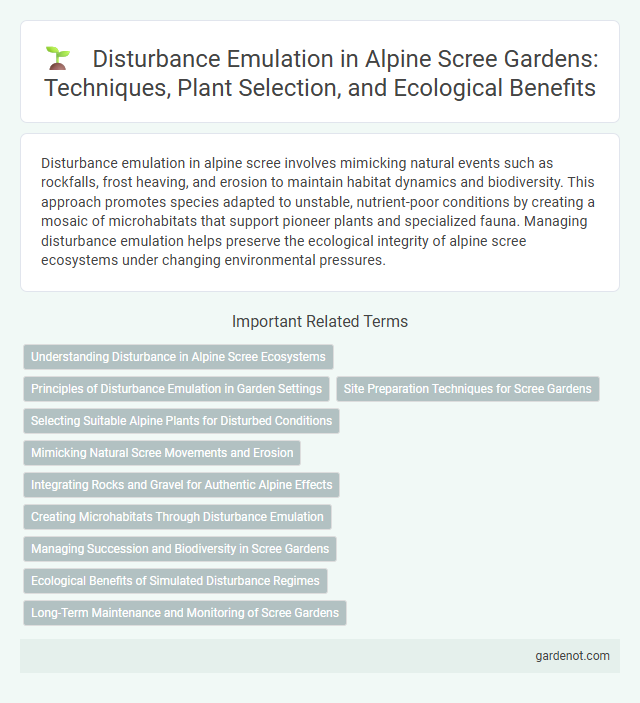Disturbance emulation in alpine scree involves mimicking natural events such as rockfalls, frost heaving, and erosion to maintain habitat dynamics and biodiversity. This approach promotes species adapted to unstable, nutrient-poor conditions by creating a mosaic of microhabitats that support pioneer plants and specialized fauna. Managing disturbance emulation helps preserve the ecological integrity of alpine scree ecosystems under changing environmental pressures.
Understanding Disturbance in Alpine Scree Ecosystems
Disturbance emulation in alpine scree ecosystems involves replicating natural events such as rockfalls and freeze-thaw cycles to maintain habitat heterogeneity and ecological balance. Understanding disturbance regimes is crucial for conserving specialized flora and fauna adapted to the dynamic, nutrient-poor scree environment. Modeling these disturbances enhances restoration efforts and supports biodiversity resilience in alpine regions.
Principles of Disturbance Emulation in Garden Settings
Principles of disturbance emulation in garden settings emphasize mimicking natural Alpine scree processes to promote biodiversity and ecosystem resilience. This involves replicating soil movement, rock displacement, and periodic disruptions that recreate microhabitats essential for native flora and fauna. Controlled disturbance supports successional stages, maintaining the dynamic balance characteristic of Alpine scree environments.
Site Preparation Techniques for Scree Gardens
Site preparation techniques for scree gardens often involve disturbance emulation to recreate the natural processes shaping alpine scree environments. Mechanical soil disruption mimics frost heaving and rockfall, promoting aeration and nutrient cycling crucial for alpine plant colonization. Selecting appropriate substrate composition and microrelief patterns enhances drainage and mimics native scree habitats, optimizing conditions for specialized alpine flora growth.
Selecting Suitable Alpine Plants for Disturbed Conditions
Selecting suitable alpine plants for disturbed conditions involves prioritizing species with strong adaptation to scree environments, such as Saxifraga oppositifolia and Silene acaulis, known for their resilience to soil instability and temperature extremes. These species exhibit traits like deep rooting systems and rapid colonization ability, promoting soil stabilization and ecosystem recovery after disturbance events. Incorporating native pioneer species enhances biodiversity and supports natural succession processes in alpine scree habitats.
Mimicking Natural Scree Movements and Erosion
Disturbance emulation in alpine scree involves mimicking natural scree movements and erosion processes to maintain ecological balance and biodiversity. Techniques include simulating rockfall dynamics and surface displacement patterns to replicate sediment redistribution caused by freeze-thaw cycles and gravity. This approach enhances habitat heterogeneity, supports specialized flora and fauna, and promotes natural regeneration of alpine scree ecosystems.
Integrating Rocks and Gravel for Authentic Alpine Effects
Incorporating rocks and gravel during disturbance emulation enhances the authenticity of alpine scree environments by replicating natural erosion and sediment patterns. This integration supports the physical stability of slopes while promoting microhabitats for specialized alpine flora and fauna. Optimizing particle size distribution and layering techniques ensures realistic texture and drainage characteristics, crucial for maintaining ecological balance and visual accuracy.
Creating Microhabitats Through Disturbance Emulation
Creating microhabitats through disturbance emulation in alpine scree involves replicating natural processes such as rockfall and freeze-thaw cycles to promote biodiversity. These disturbances generate varied substrate conditions and microclimates, fostering habitat diversity for specialized flora and fauna. By mimicking these dynamics, conservation efforts enhance species resilience and ecological complexity in fragile scree ecosystems.
Managing Succession and Biodiversity in Scree Gardens
Disturbance emulation techniques in alpine scree gardens mimic natural rockfall and soil shifts to manage succession and maintain biodiversity. Regularly disturbing scree substrates prevents dominant vegetation from establishing, allowing diverse pioneer species adapted to early successional stages to thrive. This approach enhances habitat heterogeneity, supporting rare alpine flora and invertebrates specialized in unstable, dynamic environments.
Ecological Benefits of Simulated Disturbance Regimes
Simulated disturbance regimes in alpine scree ecosystems promote biodiversity by recreating natural processes such as rockfall and soil displacement, which maintain habitat heterogeneity. These disturbances facilitate colonization by pioneer species and prevent competitive exclusion, enhancing ecosystem resilience. Repeated disturbance emulation supports nutrient cycling and successional dynamics crucial for sustaining alpine scree ecological functions.
Long-Term Maintenance and Monitoring of Scree Gardens
Long-term maintenance and monitoring of alpine scree gardens involve periodic assessment of slope stability, vegetation health, and soil composition to emulate natural disturbance regimes effectively. Installing remote sensors and conducting seasonal surveys provide critical data to adjust management practices, ensuring the preservation of biodiversity and erosion control. Adaptive interventions based on monitoring outcomes support the dynamic equilibrium of scree ecosystems, enhancing resilience against climatic and anthropogenic changes.
Disturbance emulation Infographic

 gardenot.com
gardenot.com